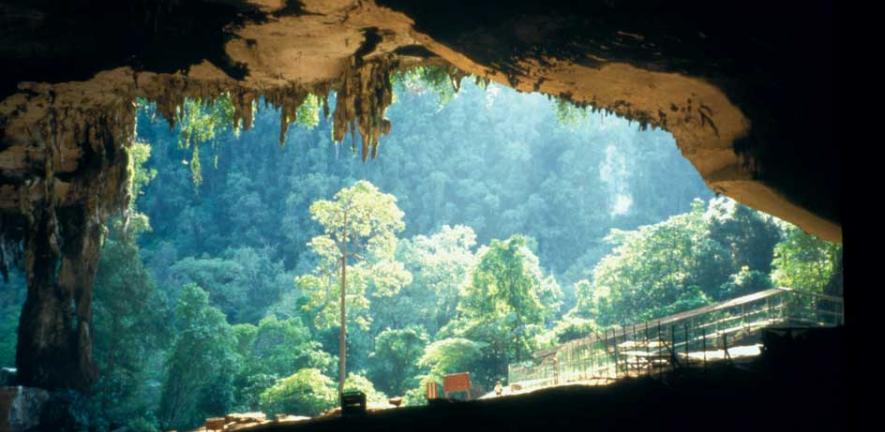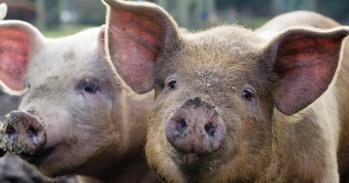
Understanding our biological past is a tricky business. It's like trying to build a jigsaw puzzle when most of the pieces are missing. However, bioarchaeologists at the University of Cambridge are doing just that through the study of human-environment interactions within a historic and prehistoric framework, often with surprising results.
Understanding our biological past is a tricky business. It's like trying to build a jigsaw puzzle when most of the pieces are missing. However, bioarchaeologists at the University of Cambridge are doing just that through the study of human-environment interactions within a historic and prehistoric framework, often with surprising results.
The ‘Niah Cave Project’ is one such example. Led by Professor Graeme Barker and primarily funded by the Arts and Humanities Research Council (AHRC), this project looks at the bioarchaeological record of change in Sarawak, Borneo over a period of 45,000 years. Niah Cave comprises a series of enormous caverns in what is now known as Niah National Park. With clear evidence of long-term human use, these caverns have produced the oldest human skeletal remains found anywhere in Southeast Asia.
Findings from this ongoing research shatter the traditional image of early Modern Humans as ‘primitive’ hunter-gatherers; as opportunistic foragers whose search for food was limited to only what was readily available. The extensive range of food remains – charred plant tissues, nut and fruit fragments, starch grains, molluscs, and bone fragments of large and small mammals, birds, bats and fish – provide striking evidence of effective foraging strategies in the challenging environment of a tropical rainforest. From the remains of monkey bones and tools left in the cave, we can tell that early foragers hunted in an organised and sophisticated way, developing methods not only to obtain food on ground level but also high up within the forest canopy. Processing toxic plants as well as managing the landscape through forest burning is further evidence of the ability of the Niah Cave occupants to make good use of the resources available and experiment with subsistence strategies.
So our picture of early Modern Humans is significantly evolving as a result of ongoing bioarchaeological research. Early foragers showed the ability to forward plan and adapt, challenging previous thought on human-environment evolution which asserted that humans did not exploit their environment until the advent of farming. As Dr Ryan Rabett who works on the project explains, ‘As our understanding and appreciation of the past becomes more sophisticated, we are continuously being asked to re-evaluate our perception of how the relationship between humans and their environment has evolved over time.’
As well as offering valuable insights into our biological past, rather surprisingly, much bioarchaeological research involves a close correlation with studies in the present. We are what we eat, so the saying goes, and that was as true thousands of years ago as it is today. Fortunately for bioarchaeologists, the type of diet eaten by an individual leaves an identifiable chemical ‘signature’ in skeletal and other remains. Funded by the Wellcome Trust, Dr Tamsin O’Connell is helping to decipher these signatures and add more to their meaning. Her research measures the chemical signals in consumer (human or animal) tissues that can be linked to the food they have eaten or the water they have drunk. These signals can be related to either the food or water itself or its source. This analysis of ancient diet can provide a host of information about food, subsistence strategies, demography, economy and environment.
The key technique is that of isotope analysis. Common elements such as carbon and nitrogen exist in different isotopic forms, which are present at stable ratios within the environment. Within living organisms, however, the isotopes are processed and integrated into body tissues in subtly different ways. As a result, the isotope ratios within different plants and animals tend to deviate from environmental norms in distinctive ways. Analysis of these ratios in tissues can thus provide information about diet, position in the food chain and other factors. In archaeological specimens, therefore, isotope analysis can provide clues to ancient dietary habits.
To analyse ancient diets, there needs to be a solid understanding of how the chemical signals get into the different parts of the body commonly found at archaeological sites such as bone and hair. This is achieved through studies on modern diets and body tissue. A better understanding of the links between diet and isotopic ratios in people and animals today provides key baseline data for work on prehistoric specimens.
This technique is also of interest to ecologists studying modern animal populations. As Dr O'Connell explains, ‘Bioarchaeologists use this technique to gain information about consumers from the consumers themselves. We do this because we can't ask them – they are dead. A lot of ecologists are now trying to answer questions about animal populations – they can't ask them because they can't speak, and it is difficult to track them all the time. By analysing the isotopic signal across animal whiskers, for example, we are able to build a picture of their diet and subsistence strategies over their lifetime.’
Modern issues of resource, environment and biodiversity sustainability are areas to which bioarchaeology is making an increasing contribution, as growing knowledge and understanding of the past relates to the present day. Horse breeding is an excellent example. Horses have played a significant part throughout human history. Before the development of firearms the horse was crucial to warfare; before the invention of the steam engine it was the fastest and most reliable form of land transport. Today its importance in the undeveloped and developing world has scarcely diminished and even in the developed world it is of great economic importance to sport and leisure industries.
In addition to studies which focus on gaining a greater understanding of the past history of horses, research is also being undertaken which is critical for the existence of present and future generations of horses. The field of archaeogenetics, where genetics methods are used to answer archaeological questions, is playing a key role in this. Boosted by funding from the Isaac Newton Trust, a DNA project, led by Dr Mim Bower, is analysing whether remote, isolated populations of horses preserve the genetic signature of extinct horse populations and whether this can tell us about how, where and when horses were domesticated in the past. This data is also crucial to conservation genetics as many horse breeds in central Asia have become extinct in the last 50-60 years and more are likely to follow.
An ancient DNA study of historic thoroughbred horses, including Eclipse, the stallion described as the greatest racehorse of all time, is also underway. In a Horse Racing and Betting Levy Board funded project on genetic variation in thoroughbred horses, scientists from Cambridge University and the Royal Veterinary College hope to understand what makes thoroughbreds more susceptible to bone and ligament diseases or more likely to break down in training; research with positive implications for the future.
Bioarchaeological research into crops may also hold the key to sustainable, renewable energy resources for the future. Using modern and ancient DNA, Cambridge bioarchaeologists are leading investigations into the spread and ancestry of crops. With Professor Martin Jones, Dr Diane Lister has been looking at the spread of wheat and barley cultivation as part a Natural Environment Research Council (NERC) funded consortium grant in collaboration with the National Institute for Agricultural Botany and two other universities. Funded by the Wellcome and Leverhulme Trusts, Dr Harriet Hunt researches the domestication of broomcorn millet. With the developing world’s focus on ‘green energy’ from renewable sources, these crops are becoming of more interest for ecological reasons as potential candidates for ‘biofuels’ and studies into their past origins and spread could prove valuable to future research in this area.
One thing is clear – ongoing bioarchaeological research at the University of Cambridge not only increases and often challenges our understanding of our biological past. It also invites us to rethink our approach to contemporary issues such as conservation and sustainability and in some cases, by looking to the past, we may find the key to the future.
Much of the bioarchaeology research currently being undertaken in the University of Cambridge is funded by the AHRC, NERC, Wellcome Trust, Leverhulme Trust, Isaac Newton Trust, The International Society for Science and Religion, and The McDonald Institute for Archaeological Research. Investment by the Leverhulme and Wellcome Trusts is also exemplified by the Leverhulme Centre for Human Evolutionary Studies in its new home, the Henry Wellcome Building.
This work is licensed under a Creative Commons Licence. If you use this content on your site please link back to this page.





